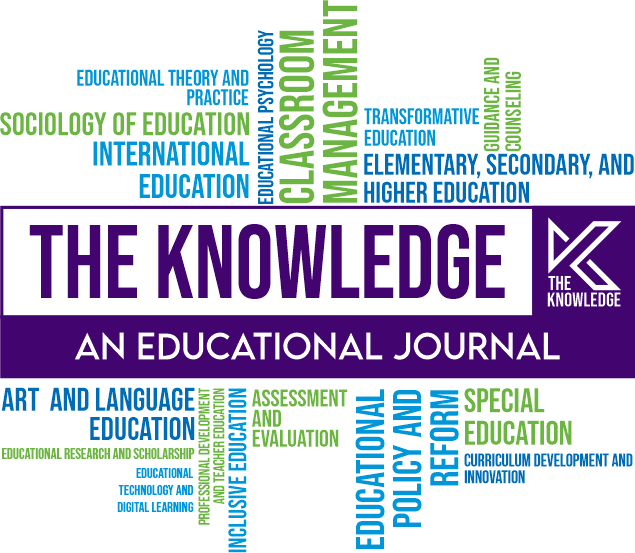The Acceptance of Educational Content and University Support: Effects of E-learning Acceptance and Student Computer Competency
DOI:
https://doi.org/10.63062/tk/2k24a.31013Keywords:
Course Content, University Support, Computer Competency, E-learning AcceptanceAbstract
E-learning among university students is examined through educational content acceptance and university support, highlighting students' computer competency mediating effect. To optimize e-learning environments, it is essential to understand elements enhancing ELA. In the present study, 500 university students enrolled in e-learning courses were surveyed quantitatively. SEM analyzes the association among variables and measures constructs via validated scales. Moreover, It is hypothesized that construct educational content acceptance and university support positively influence ELA, with students' computer competency acting as a mediating factor. Hence, ELA is significantly predicted by both educational content acceptance and university support, with computer competency partially mediating the relationship. Using empirical evidence, this study provides actionable insights to educational institutions seeking to improve learning effectiveness.
References
Abumandour, E. S. T. (2020). Public libraries' role in supporting e-learning and spreading lifelong education: A case study. Journal of Research in Innovative Teaching & Learning, 14(2), 178-217. https://doi.org/10.1108/jrit-06-2019-0063
Ahmad, T., & Sheikh, A. (2022). Impact of information and communication technologies (ICT) on student's learning: a case from University of the Punjab, Pakistan. Digital Library Perspectives, 38(2), 205–221. https://doi.org/10.1108/dlp-03-2021-0027
Akter, S., Fosso Wamba, S., & Dewan, S. (2017). Why PLS-SEM is suitable for complex modeling? An empirical illustration in big data analytics quality. Production Planning & Control, 28(11-12), 1011-1021. https://doi.org/10.1080/09537287.2016.1267411
Akram, N., Zubair, S. S., Asghar, F., Nishtar, Z., & Lodhi, K. (2023). Public-private partnerships (PPPs) in construction projects: A study on the utilization, effectiveness, and challenges in Pakistan. Bulletin of Business and Economics (BBE), 12(3), 402-409. https://doi.org/10.61506/01.00047
Al-Azawei, A., Parslow, P., & Lundqvist, K. (2016). Barriers and opportunities of e-learning implementation in Iraq: A case of public universities. The International Review of Research in Open and Distributed Learning, 17(5), 126-146. https://doi.org/10.19173/irrodl.v17i5.2501
Al-Okaily, M., Alqudah, H., Matar, A., Lutfi, A., & Taamneh, A. (2020). Dataset on the Acceptance of e-learning System among Universities Students' under the COVID-19 Pandemic Conditions. Data in brief, 32, 106176. https://doi.org/10.1016/j.dib.2020.106176
Alqahtani, A. Y., & Rajkhan, A. A. (2020). E-learning critical success factors during the COVID-19 pandemic: A comprehensive analysis of e-learning managerial perspectives. Education sciences, 10(9), 216. https://doi.org/10.3390/educsci10090216
Archambault, L., Leary, H., & Rice, K. (2022). Pillars of online pedagogy: A framework for teaching in online learning environments. Educational Psychologist, 57(3), 178-191. https://doi.org/10.1080/00461520.2022.2051513
Arnas, Y., Ahmad, A., & Fajarianto, O. (2023). The Effectiveness of Learning Management System in Higher Education: A Case Study of Social Sciences Course Content. IJESS International Journal of Education and Social Science, 4(2), 114-118. https://doi.org/10.56371/ijess.v4i2.185
Asghar, F., Farooq, P., Nadim, M., ul Abidin, Z., & Wadood, F. (2023). Global Financial Crisis: A critical study on Role of Auditor’s and Stakeholder. Journal of Policy Research (JPR), 9(2), 452–458. https://doi.org/10.5281/zenodo.8273338
Davis, F. D. (1989). Perceived usefulness, perceived ease of use, and user acceptance of information technology. MIS Quarterly, pp. 319–340. https://doi.org/10.2307/249008
Duggal, S. (2022). Factors impacting acceptance of e-learning in India: learners’ perspective. Asian Association of Open Universities Journal, 17(2), 101–119. https://doi.org/10.1108/aaouj-01-2022-0010
Eze, S. C., Chinedu-Eze, V. C. A., Okike, C. K., & Bello, A. O. (2020). Factors influencing the use of e-learning facilities by students in a private Higher Education Institution (HEI) in a developing economy. Humanities & Social Sciences Communications, 7(1). https://doi.org/10.1057/s41599-020-00624-6
Fornell, C., & Larcker, D. F. (1981). Evaluating structural equation models with unobservable variables and measurement error. Journal of Marketing Research, 18(1), 39-50. https://doi.org/10.2307/3151312
Gill, M. A., Ahmad, N., Khan, M., Asghar, F., & Rasool, A. (2023). Cyber attacks detection through machine learning in banking. Bulletin of Business and Economics (BBE), 12(2), 34–45. https://bbejournal.com/BBE/article/view/443
Gama, L. C., Chipeta, G. T., & Chawinga, W. D. (2022). Electronic learning benefits and challenges in Malawi’s higher education: A literature review. Education and Information Technologies, 27(8), 11201–11218. https://doi.org/10.1007/s10639-022-11060-1
Ibrahim, N. K., Al Raddadi, R., AlDarmasi, M., Al Ghamdi, A., Gaddoury, M., AlBar, H. M., & Ramadan, I. K. (2021). Medical students’ acceptance and perceptions of e-learning during the Covid-19 closure time in King Abdulaziz University, Jeddah. Journal of Infection and Public Health, 14(1), 17–23. https://doi.org/10.1016/j.jiph.2020.11.007
Ikram, M., Kenayathulla, H. B., & Saleem, S. M. U. (2023). Unlocking the potential of technology usage in fostering education quality and students' satisfaction: A case of Pakistani higher education. Kybernetes.
Karkar, A. J. M., Fatlawi, H. K., & Al-Jobouri, A. A. (2020). Highlighting E-learning Adoption Challenges using Data Analysis Techniques: University of Kufa as a Case Study. Electronic Journal of E-Learning, 18(2), 136-149. https://doi.org/10.34190/ejel.20.18.2.003
Kazmi, S. S. A., & Hashim, M. (2015). Learning methods preferred by management students. International Journal of Academic Research in Business and Social Sciences, 5(3), 129. https://doi.org/10.6007/ijarbss/v5-i3/1506
Kumar, P., Saxena, C., & Baber, H. (2021). Learner-content interaction in e-learning-the moderating role of perceived harm of COVID-19 in assessing the satisfaction of learners. Smart Learning Environments, 8, 1-15. https://doi.org/10.1186/s40561-021-00149-8
Latip, M. S. A., the Faculty of Hotel and Tourism Management, Universiti Teknologi MARA Cawangan Terengganu Kampus Dungun, Terengganu, Malaysia, Tamrin, M., Noh, I., Rahim, F. A., & Latip, S. N. N. A. (2022). Factors affecting e-learning acceptance among students: The moderating effect of self-efficacy. International Journal of Information and Education Technology (IJIET), 12(2), 116–122. https://doi.org/10.18178/ijiet.2022.12.2.1594
Li, X., Zhang, J., & Yang, J. (2024). The effect of computer self-efficacy on the behavioral intention to use translation technologies among college students: Mediating role of learning motivation and cognitive engagement. Acta Psychologica, 246(104259), 104259. https://doi.org/10.1016/j.actpsy.2024.104259
Lin, R. (2024). Unveiling the Complexities of Student Satisfaction in E-learning: An Integrated Framework for the Context of COVID-19.
Maphosa, V., Dube, B., & Jita, T. (2020). A UTAUT evaluation of WhatsApp as a tool for lecture delivery during the COVID-19 lockdown at a Zimbabwean university. International Journal of Higher Education, 9(5), 84–93. https://doi.org/10.5430/ijhe.v9n5p84
Masadeh, R. E., Almajali, D., Alrowwad, A. A., Alkhawaldeh, R., Khwaldeh, S., & Obeid, B. (2023). Evaluation of factors affecting university students' satisfaction with e-learning systems used during the Covid-19 crisis: A field study in Jordanian higher education institutions. International Journal of Data and Network Science, 7(1), 199-214. https://doi.org/10.5267/j.ijdns.2022.11.003
Nes, A. A. G., Steindal, S. A., Larsen, M. H., Heer, H. C., Lærum-Onsager, E., & Gjevjon, E. R. (2021). Technological literacy in nursing education: A scoping review. Journal of Professional Nursing: Official Journal of the American Association of Colleges of Nursing, 37(2), 320–334. https://doi.org/10.1016/j.profnurs.2021.01.008
Puron-Cid, G., & Gil-Garcia, J. R. (2022). Are smart cities too expensive in the long term? Analyzing the effects of ICT infrastructure on municipal financial sustainability. Sustainability, 14(10), 6055. https://doi.org/10.3390/su14106055
Qazi, M. A., Sharif, M. A., & Akhlaq, A. (2024). Barriers and facilitators to adoption of e-learning in higher education institutions of Pakistan during COVID-19: Perspectives from an emerging economy. Journal of Science and Technology Policy Management, 15(1), 31-52. https://doi.org/10.1108/jstpm-01-2022-0002
Saleh, S. S., Nat, M., & Aqel, M. (2022). Sustainable adoption of e-learning from the TAM perspective. Sustainability, 14(6), 3690. https://doi.org/10.3390/su14063690
Selim, H. M. (2007). Critical success factors for e-learning acceptance: Confirmatory factor models. Computers & Education, 49(2), 396–413. https://doi.org/10.1016/j.compedu.2005.09.004
Sharif-Nia, H., Allen, K.-A., Arslan, G., Reardon, J., She, L., Ghahrani, N., Rahmatpour, P., & Fomani, F. K. (2024). E-learning acceptance: The mediating role of student computer competency in the relationship between the instructor and the educational content. Teaching and Learning in Nursing, 19(1), e5–e10. https://doi.org/10.1016/j.teln.2023.08.001
Singh Kaurav, R. P., Rajput, S., & Baber, R. (2019). Factors Affecting the Acceptance of E-learning By Students: A Study of E-learning Programs in Gwalior, India. South Asian Journal of Management, 26(1), 76–95.
Taat, M. S., & Francis, A. (2019). Factors influencing the students’ acceptance of E-learning at teacher education institute: An exploratory study in Malaysia. International Journal of Higher Education, 9(1), 133-141. https://doi.org/10.5430/ijhe.v9n1p133
Venkatesh, V., & Davis, F. D. (2000). A theoretical extension of the Technology Acceptance Model: Four longitudinal field studies. Management Science, 46(2), 186–204. https://doi.org/10.1287/mnsc.46.2.186.11926




